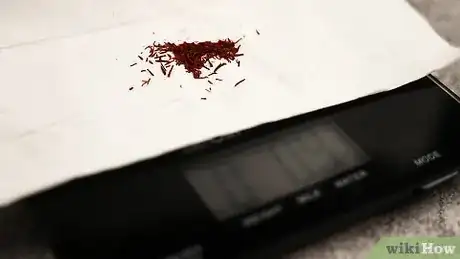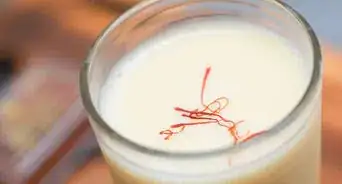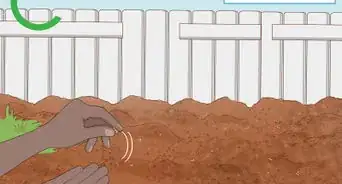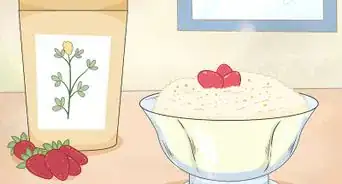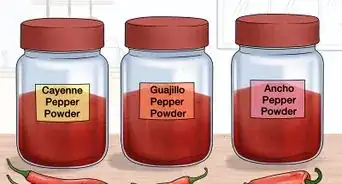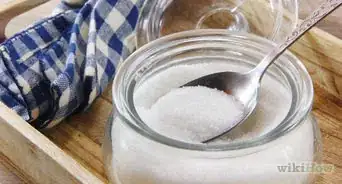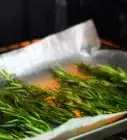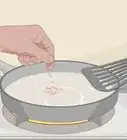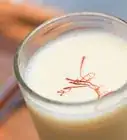This article was co-authored by wikiHow Staff. Our trained team of editors and researchers validate articles for accuracy and comprehensiveness. wikiHow's Content Management Team carefully monitors the work from our editorial staff to ensure that each article is backed by trusted research and meets our high quality standards.
wikiHow marks an article as reader-approved once it receives enough positive feedback. In this case, several readers have written to tell us that this article was helpful to them, earning it our reader-approved status.
This article has been viewed 167,647 times.
Learn more...
When it comes to spices, saffron is definitely one of the most exotic. Not only does it add a rich orange color to dishes such as paella and risotto, it has a pungent, slightly bitter taste that adds a complexity to any recipe. However, if you want to get the most out of your saffron, it's important to know how to prepare it in order to draw the flavor and color out of the threads.
Steps
Crushing Saffron
-
1Dry the saffron strands. Take out your saffron strands and lay them out on a paper towel. Let them rest out to dry for 10 to 15 minutes prior to preparing the threads.
-
2Measure the saffron threads. Your recipe will usually tell you how much saffron to use, but there are some general rules that are good to know. Saffron is usually measured in grams, the number of threads, or “pinches.” A “pinch” typically means 20 medium-sized threads of saffron. Use a food scale or count the threads to measure out the saffron.[1]
- Adding too much saffron can ruin a dish, so it's best to err on the side of too little. You can always add more if the taste and color isn't to your satisfaction.
- Counting the saffron threads usually offers the most accurate measurement.
- If you're adding saffron on your own, the rule of thumb is usually to add three strands for each person that you're serving. Three strands is approximately a ½ teaspoon.[2]
Advertisement -
3Crush the threads. For saffron to really shine in your dish, you need to ensure that its flavor and color are released. The quickest way to do that is to break down the threads. Saffron threads are very delicate, so it's easy to crush them with your hand. Use your thumb and forefinger to gently grind the threads into pieces. However, if you prefer a more uniform look to the pieces of saffron in your recipe, use a mortar and pestle to crush the threads.[3]
- Crushing saffron for use in recipes typically works best if you're making a recipe that already has water or another cooking liquid in it, such as risotto or paella.
- Keep in mind that crushing saffron by hand or with a mortar and pestle doesn't offer the most attractive appearance because the threads are no longer in tact. However, you can still get a strong flavor, aroma, and color from crushed saffron.
-
4Add to your dish. Once you've crushed the saffron threads, simply mix them into your recipe. It's best to add crushed saffron as early on in the cooking process as possible. That way, there's enough time for its flavor to infuse the other ingredients and its color to deepen the recipe.[4]
- Make sure that there's already some type of liquid in your pot or pan before mixing in the crushed saffron threads.
Soaking Saffron
-
1Heat a liquid of your choice. If you're making a recipe that calls for some type of liquid, such as chicken stock, milk, or white wine, pour enough of the liquid to cover the amount of saffron that you're using into a pan or pot. Next, heat the liquid on the stove until it's hot. Be careful not to bring it to a boil, though.[5]
- If your dish doesn't necessarily call for liquid, you can use plain water.
-
2Soak the saffron threads. The most effective way to draw the flavor and color out of saffron is to submerge them in a hot liquid, so you want to soak them thoroughly before adding them to your recipe. In most cases, letting it sit in the liquid for 10 to 20 minutes is enough to prepare the saffron.[6]
- Soaking the saffron before adding it to your recipe is the best way to ensure that it's distributed evenly throughout the dish.
- You can usually tell that your saffron has soaked long enough when the liquid starts to give off a strong aroma.
- You can crush the threads by hand or with a mortar and pestle before soaking them, but using the whole strands can add an attractive look to your dish.
- If you really want a robust flavor and color from your saffron, try soak the threads in room temperature water overnight. Then you can add them to warm chicken stock, milk, wine, or another liquid before adding them to your dish.
-
3Mix the liquid into your dish. When it comes time to add the saffron to your recipe, you don't just want to remove the threads from the liquid and mix them in. Instead, add all of the liquid, so you get a deeper, richer flavor that pervades the entire dish. Typically, the best time to add the saffron liquid is near the end of cooking, but follow the instructions in your recipe.[7]
- You can strain the threads and add only the liquid to your dish if you prefer, but that's usually only necessary if you're making a recipe that should have a clear appearance, such as a jelly.
- If you plan to leave the threads in your recipe, there's no need to cut or chop them. The intact threads can add texture and visual interest to your dish.
Choosing Saffron
-
1Avoid powdered saffron. Powdered or ground saffron may be cheaper than saffron threads, but there's a good reason for that. It doesn't have the same flavor, aroma, and color as fresh saffron, so it doesn't provide the same rich taste and appearance. In fact, powdered saffron often contains paprika, turmeric, and bark from inferior saffron threads.[8]
-
2Look for a deep color. Saffron threads should have a deep red color with orange tips. If you notice that the threads don't have orange near the ends, it can be a sign of inferior saffron that's been dyed to have a richer color.[9] Make sure that the color is uniform too -- lighter streaks throughout the threads can be a sign of poor quality.[10]
- In general, the deeper the color that saffron has, the higher quality it is.
-
3Pay attention to the texture. High quality saffron threads are typically fine and uniform in size. One end usually has a trumpet-like shape, while other has a thin, tendril-like appearance. If you notice that the saffron is irregularly shaped, features shreds instead of strands, or contains bark, it's probably inferior quality.[11]
- If the threads have a frayed, almost worn appearance, that can also be an indication that the saffron is poor quality.
Community Q&A
-
QuestionWill saffron dissolve in water?
 Community AnswerSaffron doesn't dissolve in water. When you soak in water or another liquid, it helps draw the rich flavor and color out of the saffron and into the liquid. You can then add the liquid, with the saffron threads still in it, to your dish.
Community AnswerSaffron doesn't dissolve in water. When you soak in water or another liquid, it helps draw the rich flavor and color out of the saffron and into the liquid. You can then add the liquid, with the saffron threads still in it, to your dish. -
QuestionCan I use saffron in curries and soups? What flavor will I get?
 Community AnswerSaffron is often used in curries and soups, so it's an ideal addition to your favorite recipe. It adds a bitter, flowery taste, as well as a rich orange color.
Community AnswerSaffron is often used in curries and soups, so it's an ideal addition to your favorite recipe. It adds a bitter, flowery taste, as well as a rich orange color. -
QuestionCan saffron be used for lamb stew?
 Community AnswerSaffron is often used in lamb stews and dishes to add a rich, pungent taste. It's best to start with a small amount, though, because too much saffron can easily overwhelm a recipe.
Community AnswerSaffron is often used in lamb stews and dishes to add a rich, pungent taste. It's best to start with a small amount, though, because too much saffron can easily overwhelm a recipe.
Things You'll Need
- Mortar and pestle
- Cooking liquid
- Pot or pan
- Bowl for soaking
References
- ↑ http://www.telegraph.co.uk/foodanddrink/11167739/Five-ways-to-use-saffron.html
- ↑ https://www.npr.org/2010/12/07/131728204/saffron-you-can-have-too-much-of-a-good-thing
- ↑ http://www.finecooking.com/articles/geting-the-most-from-saffron.aspx
- ↑ http://www.seriouseats.com/2011/01/spice-hunting-saffron-how-to-use-guide.html
- ↑ http://www.finecooking.com/articles/geting-the-most-from-saffron.aspx
- ↑ http://www.finecooking.com/articles/geting-the-most-from-saffron.aspx
- ↑ http://www.bbcgoodfood.com/glossary/saffron
- ↑ http://www.seriouseats.com/2011/01/spice-hunting-saffron-how-to-use-guide.html
- ↑ http://www.bbcgoodfood.com/glossary/saffron
About This Article
To get the best flavor out of saffron, measure the number of threads you want in your dish, then crush them with your fingers or a mortar and pestle. Add the crushed threads to your dish as early as possible to allow the saffron flavor to infuse the other ingredients, as well as to allow saffron’s vibrant color to spread. Keep reading to learn how to soak saffron!

